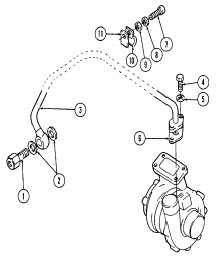|
| |
TM 5-4320-306-24
2-33. REPLACE TURBOCHARGER AND EXHAUST (TURBINE) ELBOW (Continued)
15
Position turbocharger-to-filter lube oil pipe (3) between the oil filter
and the turbocharger intake. Install three pipe clips (10) and three
end plates (11) with screws (7), three washers (8), and three rings
(9). Tighten screws only hand tight
16
Install new gasket (6) on the turbocharger oil inlet port.
17
Using two bolts (4) and two washers (5), secure lube oil pipe (3) to
the turbocharger oil inlet.
18
Secure the bolt end of lube oil pipe (3) with bolt (1) and two washers
(2).
19
Tighten screws (7) on pipe clips (10) to hold the lube oil pipe (3)
securely in position without vibration.
OPERATIONAL CHECK
WARNING
Touching exhaust system during test can cause severe burns.
CARBON MONOXIDE (EXHAUST GAS) CAN KILL YOU
Exposure to exhaust gases produces symptoms of headache,
dizziness, loss of muscular control, drowsiness, or coma.
Brain damage or death can result from severe exposure. Fumes
from engines become concentrated with poor ventilation. Operate
engine in a ventilated area only.
While running engine, be alert for fumes. If someone is overcome,
expose to fresh air, keep warm and still; give artificial respiration if
needed. Seek medical attention. Administer oxygen, if available.
GOOD VENTILATION IS THE BEST DEFENSE AGAINST EXHAUST
POISONING.
1
Start engine and check for loose, rattling components. Tighten as necessary to prevent rattles
2
Check for oil leaks around lube oil line connections to the turbocharger, at the oil filter, and at the front cap of the
return line Tighten connections and reseat gaskets as necessary.
2-117
|

